

Auditory Processing Disorder (APD) Auditory Processing Disorder International Research. Audiology Online. 20Q: CAPD - Diagnosis and Intervention Gail Chermak 20Q with Gus Mueller Auditory Processing Disorders (CAP/APD) VA Selections 17875. From the Desk of Gus Mueller We’re pleased to have Gail Chermak, PhD, back with us this month at 20Q, to continue the discussion on the topic of central auditory processing disorders (CAPD).
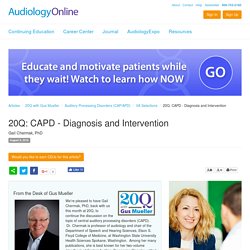
Dr. Chermak is professor of audiology and chair of the Department of Speech and Hearing Sciences, Elson S. Floyd College of Medicine, at Washington State University Health Sciences Spokane, Washington. Among her many publications, she is best known for her two-volume Handbook of Central Auditory Processing Disorder, edited with Frank Musiek, now in its 2nd edition—a must-have reference source for anyone involved with CAPD.
In last month's 20Q, Dr. Gus Mueller, PhDContributing EditorAugust 2016 To browse the complete collection of 20Q with Gus Mueller CEU articles, please visit www.audiologyonline.com/20Q 20Q: CAPD - Diagnosis and Intervention Learning Objectives 1. Oh, yes. 2. 3. To be clear, the tests I just described are for screening. 4. 5. 6. 7. Yes. 8. 9. 10. Not to a great extent. 11. 12. 13. 14. 20Q: CAPD - Fundamentals Gail Chermak 20Q with Gus Mueller Auditory Processing Disorders (CAP/APD) From the Desk of Gus Mueller The ’60s and ‘70s were exciting times for clinical audiologists conducting behavioral testing.
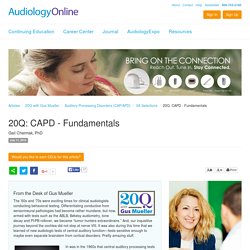
Differentiating conductive from sensorineural pathologies had become rather mundane, but now, armed with tests such as the ABLB, Békésy audiometry, tone decay and PI/PB rollover, we became “tumor hunters extraordinaire.” And, our inquisitive journey beyond the cochlea did not stop at nerve VIII. It was also during this time that we learned of new audiologic tests of central auditory function—tests sensitive enough to maybe even separate brainstem from cortical disorders. Pretty amazing stuff. In was in the 1960s that central auditory processing tests like the still-popular Dichotic Digits, SSI and SSW were introduced. Searched 'Auditory processing disorder' of Articles. Acoustic Reflex Threshold (ART) Patterns: An Interpretation Guide for Students and Supervisors Diana C. Emanuel Hearing Evaluation - Adults Hearing & Hearing Loss Hearing Eval/Scre...
Introduction Students studying audiological testing enter the clinic with varying degrees of competency regarding the interpretation of acoustic reflex threshold (ART) test results.
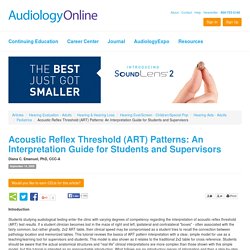
If a student clinician becomes lost in the maze of right and left, ipsilateral and contralateral "boxes" - often associated with the fairly common, but rather ghastly, 2x2 ART table, then clinical speed may be compromised as a student tries to recall the connection between pathology location and memorized tables. This tutorial reviews the basics of ART pattern interpretation with a clear, simple model for use as a teaching/learning tool for supervisors and students.
This model is also shown as it relates to the traditional 2x2 table for cross reference. Students should be aware that the actual anatomical structures and "real life" clinical interpretations are more complex than those shown with this simple model, but this tutorial is intended as an approachable introduction. An Overview of (Central) Auditory Processing Disorders Jennifer B. Shinn Auditory Processing Disorders (CAP/APD) 782.
Introduction (Central) auditory processing disorders [(C)APD], as defined in the 2005 Technical Report by the American Speech-Language and Hearing Association (ASHA), are "difficulties in the perceptual processing of information in the central auditory nervous system (CANS) and the neurobiological activity that underlies that processing and gives rise to the electrophysiological auditory potentials.
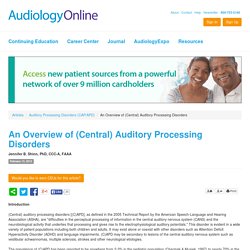
" This disorder is evident in a wide variety of patient populations including both children and adults. APD, ADD, ADHD and AD/HD: Personal and Scientific Reflections Katherine A. O'Neill Auditory Processing Disorders (CAP/APD) Hearing & Hearing Loss Hearing Eval/Screen - Children/Spe... Introduction: I'm not a stranger to research or behavioral conditions based in physiology.
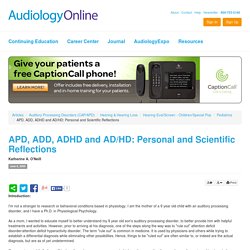
I am the mother of a 9 year old child with an auditory processing disorder, and I have a Ph.D. in Physiological Psychology. As a mom, I wanted to educate myself to better understand my 9 year old son's auditory processing disorder, to better provide him with helpful treatments and activities. However, prior to arriving at his diagnosis, one of the steps along the way was to "rule out" attention deficit disorder/attention deficit hyperactivity disorder. The term "rule out" is common in medicine. APD Evaluation to Therapy: The Buffalo Model Jack Katz Auditory Processing Disorders (CAP/APD) 945. The Buffalo Model is a conceptualization of auditory processing disorders (APD) based on the results of a three-test battery.
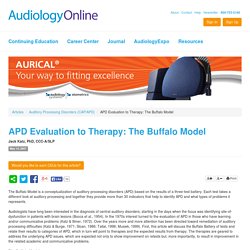
Each test takes a different look at auditory processing and together they provide more than 30 indicators that help to identify APD and what types of problems it represents. Audiologists have long been interested in the diagnosis of central auditory disorders; starting in the days when the focus was identifying site-of-dysfunction in patients with brain lesions (Bocca et al., 1954).
In the 1970s interest turned to the evaluation of APD in those who have learning and/or communicative problems (Katz & Illmer, 1972). Over the years more and more attention has been directed toward remediation of auditory processing difficulties (Katz & Burge, 1971; Sloan, 1986; Tallal, 1996; Musiek, 1999).
APD in Children: A Time-Compressed Overview Rebekah F. Cunningham Auditory Processing Disorders (CAP/APD) Aural Habilitation - Children Pediatrics 11953. Editor’s Note: This text course is an edited transcript of a live seminar.
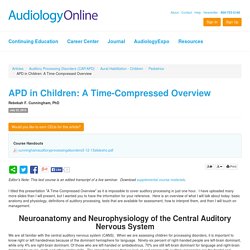
Download supplemental course materials. I titled this presentation "A Time-Compressed Overview" as it is impossible to cover auditory processing in just one hour. I have uploaded many more slides than I will present, but I wanted you to have the information for your reference. Here is an overview of what I will talk about today: basic anatomy and physiology, definitions of auditory processing, tests that are available for assessment, how to interpret them, and then I will touch on management.
Auditory Development Series: Auditory Development Hierarchy MaryKay Therres Aural Habilitation - Children Cochlear Implants Pediatrics 15458. This text course is an edited transcript of a MED-EL live webinar on AudiologyOnline.

Download supplemental course materials. Learning Objectives Today, Participants will be able to list play milestones for children ages birth to six years, describe auditory strategies to use when facilitating listening and spoken language development, list an auditory hierarchy along with goals at each level, and develop purposeful play activities that specifically target listening goals. Purposeful Play One of the first things we need to know when we are working with children is how to play, so we should know play milestones that are appropriate for young children. Purposeful play is a lesson plan. Why do we choose play? Auditory Fusion Test-Revised Robert Keith Auditory Processing Disorders (CAP/APD) 1232. Abstract.

Auditory Processing Disorders: An Overview of Current Research James W. Hall III APD Series 2014 Auditory Processing Disorders (CAP/APD) VA Selections 12703. Editor’s Note: This text course is an edited transcript of a live seminar.
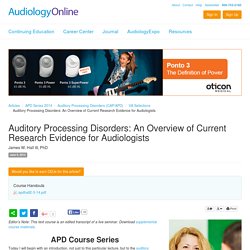
Download supplemental course materials. APD Course Series Today I will begin with an introduction, not just to this particular lecture, but to the auditory processing disorders webinar series on AudiologyOnline. Auditory Processing in Adults: Beyond the Audiogram Gail M. Whitelaw Auditory Processing Disorders (CAP/APD) 898. Introduction Audiologists are faced daily with patients who report communication issues that they may attribute to hearing loss. These types of communication issues may include difficulty hearing in less than optimal listening situations, reliance on visual information to augment auditory information, a reduced appreciation of listening to music, and difficulty understanding speech when the speaker is unfamiliar. Patients report that these communication issues impact the quality of their lives- often the reason for seeking audiology services. Auditory Processing Disorders and Dyslexic Children. Deborah Moncrieff Auditory Processing Disorders (CAP/APD) 6833.
More children with learning and reading disabilities are being referred to audiologists for hearing and auditory processing evaluations. In the past, children with these problems were evaluated by educational specialists, speech-language pathologists, neurologists, psychologists and psychiatrists. These children were often found to have various difficulties, including problems with visual-spatial organization, receptive and expressive language, phonology, attention, and in some cases, auditory processing disorders. Most tests were administered across the table from the child, in regular classrooms, with the acoustic material delivered by a cassette recorder or by the clinician, at a conversational level. While these methods indicated a number of children had auditory processing difficulties, it was apparent that more stringent, controlled procedures, such as those typically used by audiologists, might yield better results.
A good example is children with dyslexia. Hynd, G. Hynd, G. Auditory Processing Disorders in Children: Beyond the Audiogram Gail M. Whitelaw Auditory Processing Disorders (CAP/APD) 11184. Editor’s note: This is an edited transcript of an AudiologyOnline live webinar. Download supplemental course materials. Introduction I want to begin with a scenario: a school-aged child presents at your clinic, and they have difficulty hearing and listening in the presence of background noise. You know there is an old adage in medicine that says, "When you hear hoof beats, think horses.
" So when most audiologists hear this complaint from parents or teachers, they automatically think that this is possibly a sensorineural hearing loss. Behavioral Verification of Speech Recognition Benefit for Children with FM Systems Coupled to Cochlear Implants Linda M. Thibodeau Hearing Aids - Children Cochlear Implants Assisti... Introduction The options for interfacing frequency-modulated (FM) equipment with cochlear implants (CIs) are increasing with the development of new implant features and new FM options.
Because traditional methods of evaluation through informal listening checks or electroacoustic measures are typically not possible with CIs, one must ensure optimal connections and settings through systematic speech recognition measures. A protocol for verification of an FM fitting with a CI may involve informal and formal behavioral evaluations. Although informal measures are necessary to verify functioning of the local and remote microphones, more objective measurements are needed to compare different settings within an arrangement or the speech recognition benefits across different types of FM systems. The benefits provided by FM systems to school-age children who use CIs can be determined through speech recognition testing (Davies, Yellon, and Purdy, 2001; Schafer and Thibodeau, 2003).
Figure 1. Binaural Integration: An Overview Deborah Moncrieff Auditory Processing Disorders (CAP/APD) 1145. Referrals for assessment of auditory processing disorder are once again on the rise. Concern over a listener's ability to adequately code and interpret incoming auditory signals is nothing new. Helmer Mykelbust described the phenomenon with great insight in the 1950's at a time when behavioral tests for assessing skills in auditory processing were first developed. A surge in APD diagnostics occurred a couple of decades later during the 1970's. At that time, individual behavioral tests were combined into batteries for the purpose of identifying auditory processing disorders, especially in school-age children. However, nearly all of the tests were validated on adults.
Furthermore, in those early days, there were no specific remedies available to treat APD once the diagnosis had been made. (C)APD Testing and Interpreting 101: Recommendations for Audiologists Kris Erickson Auditory Processing Disorders (CAP/APD) 896. Central Auditory Processing in Clinical Practice Teri James Bellis Barbara Beck Auditory Processing Disorders (CAP/APD) 1281. Teri James Bellis, Ph.D.Department of Communication DisordersUniversity of South DakotaVermillion, SD Barbara Roe Beck, M.A.Department of Communication Sciences and DisordersSaint Louis University St. Louis, MO align=center>Clinical delivery of central auditory assessment and management services has become a much-debated topic in recent years partly due to explosive increases in referrals for such services. Requests for information regarding central auditory processing disorders (CAPD) commonly come from educators, pediatricians, speech-language pathologists, parents, educational psychologists and neurologists.
The purpose of this article is to address some of the key issues the authors believe impact the delivery of central auditory services in a clinical setting. CAPD may occur in children and adults. There are a number of common symptoms which may trigger a referral for a central auditory evaluation in a child or an adult (see Bellis, 1996 and Bellis & Ferre, 1999 for reviews). Clinical and Research Concerns - Regarding Jerger & Musiek (2000) APD Recommendations Jack Katz Cheryl DeConde Johnson Kim Tillery Tamala Bradham Susan Brandner Teryl Delagrange Je... Authors: Katz, Jack, Ph.D., University at Buffalo, SUNY, Buffalo, NY (contact jackkatz jackkatz@buffalo.edu) Johnson, Cheryl DeConde, Ed.D., Colorado Department of Education, Denver, CO Tillery, Kim L. Educational Audiology: From Observation to Recommendation Jane Madell Aural Habilitation - Children Hearing Aids - Children Pediatrics 11853.
Editor’s Note: This text course is an edited transcript of a live seminar. Download supplemental course materials. Introduction Let's talk about educational audiology and what things we see in the classroom. This has become an area that has become more interesting to me lately as I am doing consulting and not working full-time in a clinic.
I am spending more time in classrooms now than I did in the past, and I feel like I am learning a great deal. Educational Solutions for Children with Listening Challenges. Editor's note: This text course is an edited transcript of a Phonak live webinar. Learning Outcomes After this course, participants will be able to: Identify 2 pre-post questionnaires/surveys that assist in establishing benefit from classroom modifications for children with listening challenges.Name a minimum of 4 populations that may benefit from classroom modifications that boast signal to noise ratios.Describe 3 classroom modifications that may have significant benefit for children with listening challenges.
Introduction and Overview Today's world is a noisy place. My goal today is to provide information about who is at risk, and how we may need to dedicate more effort to improving their acoustic environment. These days, it seems like a lot of school districts are operating in the red. Hearing and Listening According to studies by Dahlquist (1998) and Smaldino and Crandell (2000), in a typical school setting, students spend 45% to 75% of their day listening. Gap Detection Robert Keith Auditory Processing Disorders (CAP/APD) 641. Question What are the factors for gap detection (related to parameters of procedures, stimuli, etc.)? Answer Assessment for identification of temporal processing disorders was a recommendation of the ASHA consensus conference on APD and the report of the Consensus Conference on the Diagnosis of Auditory-Processing disorders in School-Aged Children (Jerger and Musiek, 2000).
A test of temporal processing was designed by McCroskey in the early 1980's that evolved into the Random Gap Detection Test (Keith, 2000). At the moment that is the only clinical test of temporal processing that is available. The Random Gap Detection Test recording consists of a 1000 Hz calibration tone, a practice subtest for tonal stimuli and four subtests consisting of the frequencies 500, 1000, 2000, and 4000 Hz of seven-msec duration. Fan-Gang Zeng, Ph.D. at College Park, has a unique website where you can measure your own gap detection threshold to broad band noise. I hope this is helpful. Robert W. Robert W. How Accurate are Environmental Classifiers in Hearing Aids? Tao Cui Jennifer Groth Hearing Aids - Adults 19796. Learning Outcomes After this course, participants will be able to: State two ways the environmental classification is used in hearing aids.State one reason why the accuracy of environmental classification in hearing aids is important.Name one type of background noise sound that might cause an environmental classifier to classify the environment differently than a listener would.
Introduction All modern hearing aids with any kind of automatic functionality use analysis of the acoustic environment. The most basic is the compression system, which uses level detectors to determine how much gain should be applied to the input signal according to the amplification scheme. On the surface, this would seem rather simple. Because hearing aid features are often steered by the output of environmental classifiers, it is of interest to explore the accuracy of classification in different hearing aids.
Methods Subjective Classification The subjective evaluation was done in two phases. Hyperacusis - Margaret M. Jastreboff Pawel J. Jastreboff. Maximizing Outcomes for Children with Auditory Disorders: Auditory Brain Development - Listening for Learning. Maximizing Outcomes for Children with Auditory Disorders: What are Children Hearing in the Classroom? Editor’s Note: This is an edited transcript of the second webinar in a 3-part webinar series. Maximizing Outcomes for Children with Auditory Disorders: An Evidence-Based Approach to Managing Auditory Processing Disorders. Pediatric Processing Disorders: Interdisciplinary Roles and 19336.
Signia Expert Series: Speech-in-Noise Testing for Selection and Fitting of Hearing Aids: Worth the Effort? Temporal Processing Deficits in Children with Dyslexia Deborah Moncrieff Auditory Processing Disorders (CAP/APD) 1090. The National Coalition on Auditory Processing Disorders (NCAPD): History and Overview Debbie Wood Auditory Processing Disorders (CAP/APD) 1194. Using Auditory Event-Related Potentials for a Better Understanding of James Jerger 20Q with Gus Mueller Electrophysiology VA Selections 12731.